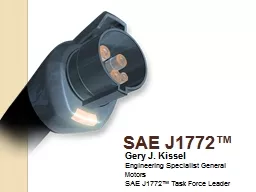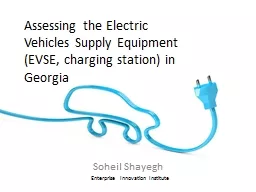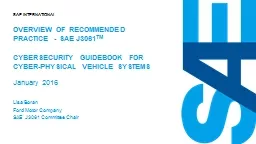PPT-SAE J1772™
Author : giovanna-bartolotta | Published Date : 2016-03-01
Gery J Kissel Engineering Specialist General Motors SAE J1772 Task Force Leader Charging What Can Be More Simple PEV Charging Consistent and Familiar Minimize
Presentation Embed Code
Download Presentation
Download Presentation The PPT/PDF document "SAE J1772™" is the property of its rightful owner. Permission is granted to download and print the materials on this website for personal, non-commercial use only, and to display it on your personal computer provided you do not modify the materials and that you retain all copyright notices contained in the materials. By downloading content from our website, you accept the terms of this agreement.
SAE J1772™: Transcript
Gery J Kissel Engineering Specialist General Motors SAE J1772 Task Force Leader Charging What Can Be More Simple PEV Charging Consistent and Familiar Minimize charging equipment. Training . for Technical Session Authors Table of Contents. Understanding the Paper Development Process. Submitting your . Abstract . Adding . Participants. Submitting your . Ready-Review Manuscript. Soheil. . Shayegh. Enterprise . Innovation Institute. Background. Atlanta:. No. 2 in Electric Vehicle (EV) . adoption. Biggest US market for Nissan Leaf sales. Incentives:. $5,000 . state tax credit. COMS 4995/6998. Julia Hirschberg. Thanks to William Wang. Sarcasm. Usage: Often used to express humor or comment. Disbelief?. Cultural differences?. Occurrence: casual conversation. Context: Effect depends on mutual beliefs of all speakers. Ms. Marlin. Advanced Animal Science. SAE . SAE. What does this have to do with supervised agriculture experience?. Why might we need to know our career paths?. Objectives. Determine how the FFA enhance SAEs.. Success Stories . KEY PRINCIPLES OF THE SAE AEROSPACE STANDARDS PROGRAM. SAE has a proven track record, with more than . 8,400 . standards published to date. . Project initiation. Published Standard. Katelyn McCants. Visited: November 13, 2015. Barbers Hill ISD. Established in 1929. Developed around petrochemical industry in the area. BH ISD includes 8 campuses: one high school, two middle schools, two . “What Does . SAE international . Offer Faculty Advisors?” . 22. .04.2015. AGENDA. Primary Activities of the SAE Faculty Advisor. Benefits of SAE International Membership for Faculty . Faculty Awards. Responsibilities. Helping students select, manage, and implement successful SAEs. Objective. Explain the role of the agricultural. e. ducation teacher in successful. s. upervised . a. gricultural experience (SAE). methods for . Small Area Estimation. . Dr . Paul . Williamson. Centre for Spatial Demographics Research. Dept. . of Geography & Planning. (1) Direct survey estimation: a recap. (3) Conventional SAE: a recap. Ms. Marlin. Advanced Animal Science. SAE . SAE. What does this have to do with supervised agriculture experience?. Why might we need to know our career paths?. Objectives. Determine how the FFA enhance SAEs.. SAE J3061 Committee Chair. Overview of Recommended Practice - SAE J3061. TM. Cybersecurity Guidebook for . cyber-physical vehicle systems. AGENDA. Copyright SAE International. 2. Motivation. Main Content of J3061. ?. . NIOSH – AMD Ambulance Testing:. And the Changing Standards Landscape. Jim Green, NIOSH, Safety Engineer. Rear Impact – 2 Tests Measured Vehicle Response at Impact. . Benmei Liu. Statistical Research and Applications Branch/. SRP/DCCPS. May 10 2018. TCRB Scientific Staff Meeting. Overview of . Small Area Estimation . (SAE). Research goals. SAE models and implementation. The SAE G-22 Aerospace Engine Supplier Quality (AESQ) Committee was established as a Technical Committee under the SAE Aerospace Council to develop, specify, maintain and promote quality standards specific to the aerospace engine supply chain. The Aerospace Standards in the AS130XX series are intended to be used together and in conjunction with other key industry quality standards to provide a comprehensive suite of interrelated quality standards that reduce customer specifics and integrate industry best practices with aerospace engine unique elements.
Download Document
Here is the link to download the presentation.
"SAE J1772™"The content belongs to its owner. You may download and print it for personal use, without modification, and keep all copyright notices. By downloading, you agree to these terms.
Related Documents














